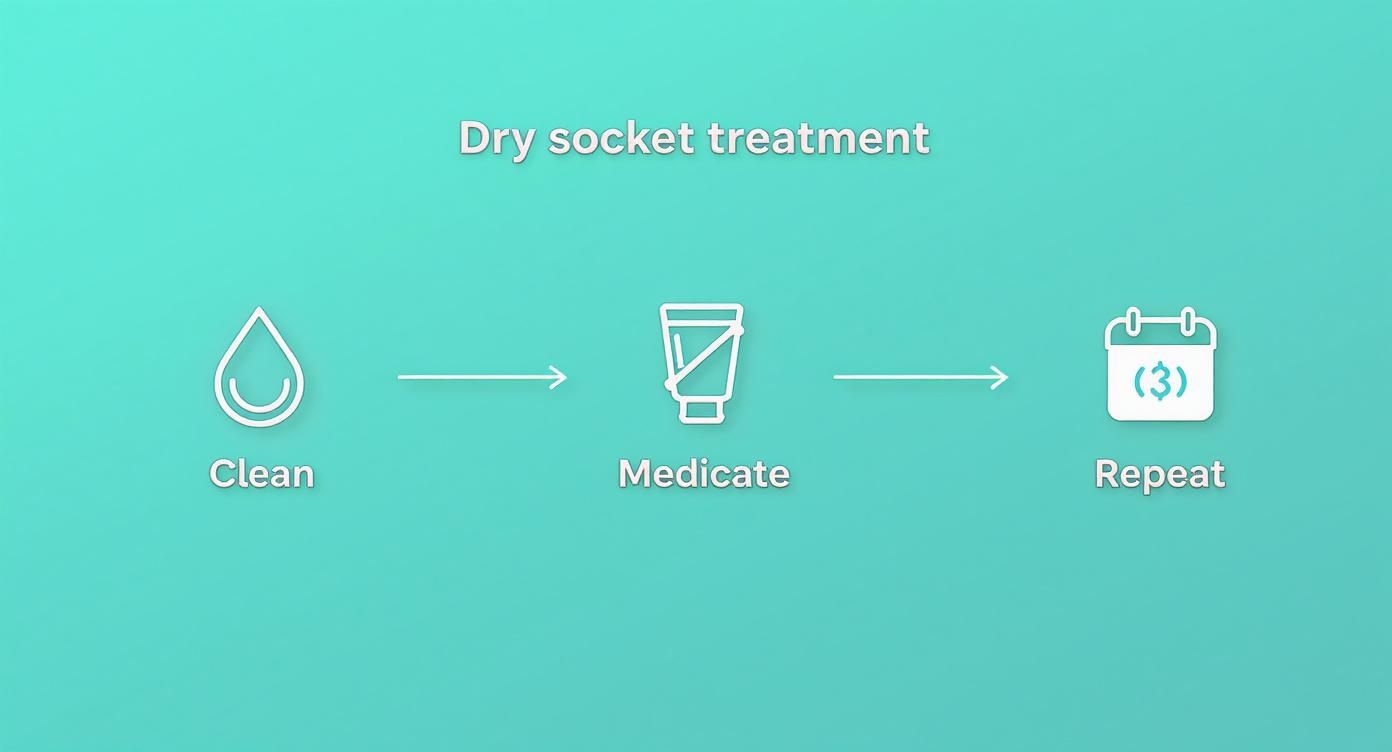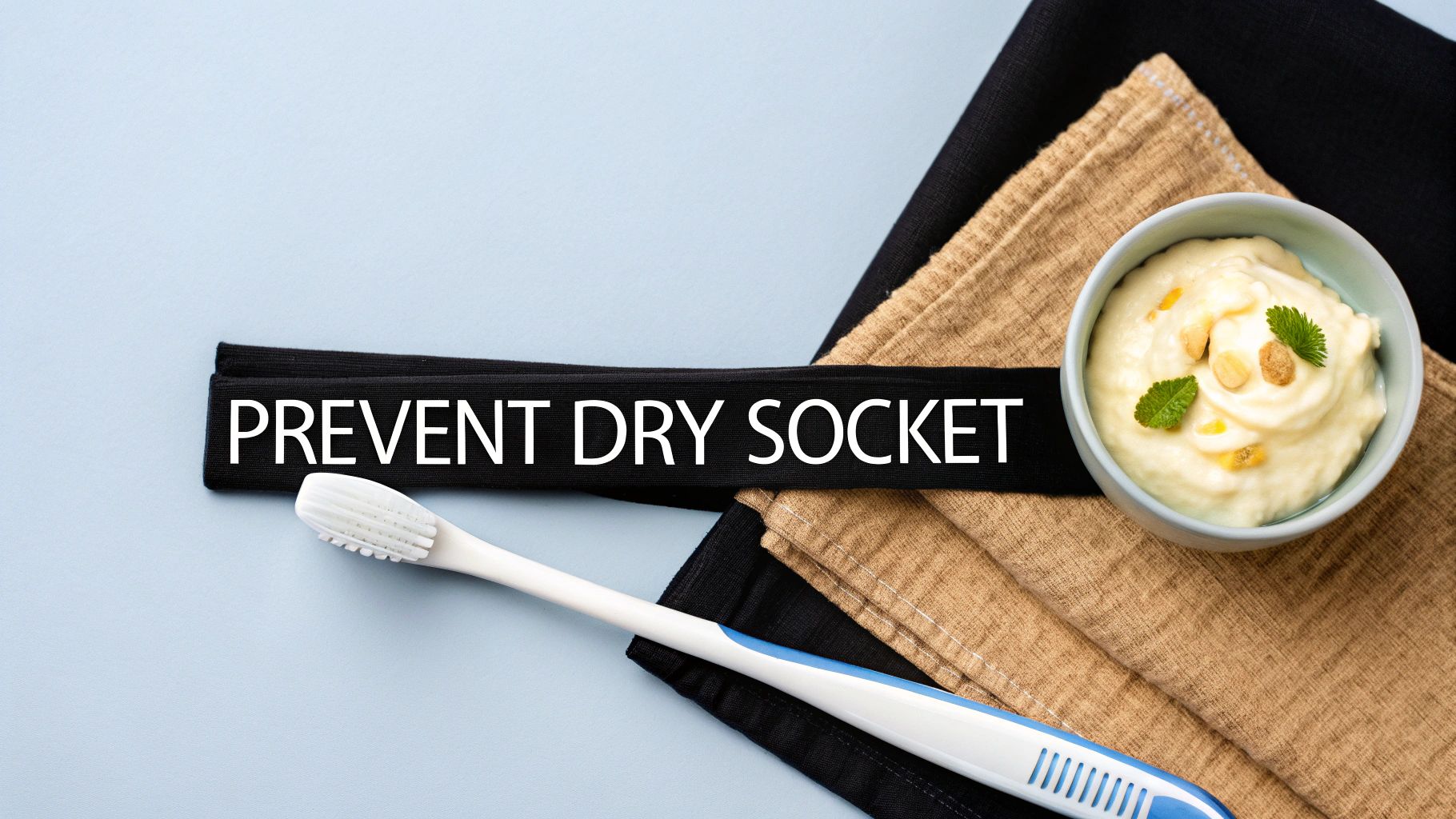What to Do If I Have Dry Socket: An Actionable Guide
- Caterina Rutter
- Oct 24
- 11 min read
If you suspect a dry socket, your first steps are crucial for immediate relief. First, gently rinse your mouth with warm salt water to clean the area. Next, take an over-the-counter pain reliever like ibuprofen and apply a cold pack to your cheek to reduce swelling.
These are temporary fixes. The most critical action is to call your dentist and schedule an appointment immediately. A dry socket requires professional care. Your dentist will clean the socket and apply a medicated dressing to stop the pain and promote proper healing.
What Exactly Is Dry Socket and How Do I Know If I Have It?

After a tooth extraction, your body forms a blood clot in the empty socket. This clot is a natural bandage that protects the underlying bone and nerves, serving as the foundation for new tissue growth.
A dry socket, or alveolar osteitis, occurs when this protective blood clot is dislodged, dissolves too early, or fails to form. This failure leaves sensitive bone and nerve endings exposed to air, food, and liquids, resulting in intense, throbbing pain.
Distinguishing Normal Healing from Dry Socket Pain
While some post-extraction discomfort is normal, dry socket pain is severe and unmistakable. It typically starts two to four days after your procedure, precisely when you expect to feel better.
The pain is not a dull ache but a severe, radiating pain that can travel from the socket to your ear, eye, or temple. Standard pain medication that worked initially may suddenly become ineffective. To better understand the sensations, refer to our guide on what a dry socket feels like.
The classic sign of a dry socket is when the pain gets significantly worse several days after your extraction instead of gradually getting better. This delayed, severe pain is the biggest red flag.
Telltale Signs Beyond the Pain
Beyond the signature radiating pain, other symptoms can confirm a dry socket. Gently look at the extraction site. A healthy socket appears dark and filled with the blood clot. A dry socket will look empty, and you might see the whitish jawbone at the bottom.
If you experience these additional symptoms, call your dentist immediately:
A nasty taste in your mouth that gentle rinsing can't resolve.
Persistent bad breath or a foul odor from the extraction site.
Visible bone at the bottom of the socket instead of a dark clot.
A low-grade fever, often below 101°F.
If this list matches your experience, it is highly likely you have a dry socket. Your next step is to seek professional treatment to manage the pain and restart the healing process.
Immediate Home Care for Dry Socket Pain Relief
If you have a dry socket, your immediate goal is to manage the intense pain until your dental appointment. These home care actions are for temporary relief, not a cure. Professional treatment is necessary for healing.
Taking these steps correctly can significantly improve your comfort. The strategy is to be extremely gentle while cleaning the area and dulling the pain. Consider this essential first aid for your mouth.
The Gentle Saltwater Rinse
A warm saltwater rinse is one of the most effective immediate actions you can take. The purpose is not to swish aggressively but to gently irrigate the area and remove food debris irritating the exposed bone.
Here is the correct technique: dissolve a half teaspoon of salt in an 8-ounce glass of lukewarm water. Avoid hot water, as it can increase inflammation.
Take a small sip of the saltwater solution.
Gently tilt your head from side to side, letting the water flow over the socket.
Do not swish, spit, or gargle. Any pressure can worsen the condition.
Open your mouth and let the water passively fall into the sink.
Perform this rinse a few times a day, especially after meals, to keep the socket clean without causing further harm.
Home care for a dry socket is about pain management, not a cure. The primary goal is to minimize your suffering until you can see your dentist for professional treatment. Gentle actions are key to avoiding further damage.
Choosing the Right Pain Medication
For the deep, inflammatory pain of a dry socket, non-steroidal anti-inflammatory drugs (NSAIDs) are your most effective over-the-counter option because they directly target inflammation.
Ibuprofen (Advil, Motrin) is a recommended NSAID that can effectively reduce pain by blocking the body's production of inflammatory hormones. Always follow the dosage instructions on the package unless your dentist advises otherwise.
Acetaminophen (Tylenol) is another option. Some find that alternating between ibuprofen and acetaminophen provides more comprehensive pain relief. Since they work differently, taking them on a staggered schedule (as directed) can be more effective than a higher dose of a single medication.
Using a Cold Compress for Numbing Relief
A cold compress is a simple but powerful tool for managing pain and swelling. Applying cold to the outside of your jaw numbs local nerve endings, providing a welcome break from the constant throbbing.
Follow these steps for maximum effectiveness:
Wrap ice or a gel pack in a thin towel. Never apply ice directly to your skin.
Hold the compress against your cheek over the painful area for 15 minutes.
Remove it for at least 15 minutes to allow your skin to recover.
Repeat this 15-on, 15-off cycle as needed throughout the day. This technique can be surprisingly effective at dulling sharp, radiating pain.
These home remedies are a bridge to your dental appointment. Professional treatment involves cleaning the socket and placing a medicated dressing, often containing eugenol (clove oil), to soothe the raw nerves and protect the exposed bone. Acting quickly at home provides immediate control and prepares you for a smoother recovery after your dentist intervenes.
What to Expect at Your Dental Visit for Dry Socket
While home care helps manage pain, a dry socket requires professional treatment to heal properly. Knowing what will happen at your appointment can reduce anxiety.
Our primary goal is to get you out of pain quickly. The entire visit is focused on providing immediate relief and setting you on the path to recovery. If you feel anxious about another dental visit, these three helpful tips to ease dental fear may be useful.
First, We Gently Clean the Socket
The first step is to gently clean the extraction site. Food particles and debris often get trapped in the socket, worsening the irritation and pain.
We will carefully flush the area with a sterile saline solution. This is not an aggressive cleaning but a gentle rinse to prepare the socket for a medicated dressing, ensuring it can work effectively.
Your dentist's main goal is to stop your pain. The cleaning and dressing are gentle procedures designed to soothe the exposed nerves, not add to your discomfort.
Next Comes the Medicated Dressing
After cleaning the socket, we will place a small medicated dressing inside. This is the step that provides significant relief.
The dressing is typically a paste or a small gauze strip soaked in a soothing solution containing eugenol (clove oil), which has powerful anesthetic and antiseptic properties. It effectively numbs the pain and keeps the area clean.
The dressing serves two functions:
It shields the exposed bone and nerves from air, food, and liquids.
It delivers soothing medication directly to the source of the pain.
Most patients feel the pain begin to subside almost immediately after the dressing is placed. It functions as both a protective bandage and a pain reliever.
Follow-Up Care is Key
Treating a dry socket may require more than one visit. Depending on the severity, we may need to see you again for follow-up care.
You might need to return every day or two for a few days to have the dressing changed. During these appointments, we will check the healing progress and apply a fresh dressing. These quick visits ensure the socket remains clean and medicated until your body can begin healing on its own.
Once the pain is fully resolved, we will stop applying the dressing, allowing the socket to heal naturally from the bottom up.
What Puts You at Risk for Dry Socket?
Developing a dry socket isn't random. Specific factors can significantly increase your risk. Understanding them is the first step toward prevention.
One of the primary risk factors is the difficulty of the extraction. A complex surgical extraction, such as for an impacted wisdom tooth, causes more trauma to the surrounding tissue. This trauma can interfere with the formation and stability of the protective blood clot.
This infographic outlines the typical dental treatment plan for a dry socket, which includes cleaning the site, placing a medicated dressing, and repeating the process as needed.

As shown, professional treatment is a process designed to protect the exposed bone and manage pain while allowing your body's natural healing mechanisms to take over.
The Trouble with Location and Complexity
The location of the extracted tooth is a significant factor. Dry socket is more common in the lower jaw (mandible) than the upper jaw (maxilla). The mandible has denser bone and a less abundant blood supply, making it more challenging to form a stable blood clot.
Molars, especially wisdom teeth, are the most frequent sites for dry sockets due to the increased surgical maneuvering often required for their removal.
I often tell my patients to think of it this way: a simple extraction is like gently pulling a plant from soft garden soil. Removing an impacted wisdom tooth is more like excavating a stubborn root from hard, rocky ground. The second one is just going to cause more disruption, which increases the risk.
Data confirms this. Alveolar osteitis occurs in about 1% to 5.6% of all tooth extractions, but this rate jumps to 6.88% for surgical extractions, compared to just 0.77% for simple ones. Research consistently shows that lower jaw extractions are more prone to this complication. For more details, you can review the research about these dental findings.
Why Tobacco and Nicotine Are a Big No-No
Using tobacco is one of the most significant and preventable risk factors for dry socket. Nicotine in cigarettes, vapes, and chewing tobacco constricts blood vessels, reducing blood flow to the extraction site.
This poor circulation directly impairs your body's ability to form a healthy blood clot. Furthermore, the physical act of inhaling or sucking creates negative pressure that can dislodge the clot from the socket.
Chemical Harm: Nicotine and other toxins inhibit the healing response.
Physical Force: The sucking motion can physically remove the protective clot.
To ensure a smooth recovery, avoid all tobacco and nicotine products for at least 48 hours after your procedure.
The table below summarizes the key risk factors and how to mitigate them.
Dry Socket Risk Factors At A Glance
Risk Factor | Impact on Dry Socket Risk | Preventive Action |
|---|---|---|
Surgical Complexity | Difficult extractions (e.g., impacted wisdom teeth) cause more tissue trauma, disrupting clot formation. | Follow all post-op instructions meticulously; discuss concerns with your surgeon. |
Location in Mouth | Lower jaw extractions, especially molars, have a higher incidence due to reduced blood supply. | Be extra vigilant with aftercare for lower molar extractions. |
Tobacco/Nicotine Use | Nicotine constricts blood vessels, and the sucking motion can dislodge the clot. | Avoid all tobacco and nicotine products for at least 48 hours post-surgery. |
Oral Contraceptives | High estrogen levels can interfere with the body's natural blood clotting mechanisms. | Schedule extractions during the last week of your pill cycle (days 23-28) when estrogen is lowest. |
Previous Dry Socket | A personal history of dry socket significantly increases the risk of recurrence. | Inform your dentist about your history so they can take extra precautions. |
Understanding these risks allows you to take proactive steps to minimize your chance of complications.
Hormonal Factors and Your Personal History
Other personal factors can also influence your risk. Oral contraceptives are a known risk factor, as high estrogen levels in many birth control pills can interfere with blood clotting.
Finally, if you have had a dry socket before, your risk of recurrence is higher, suggesting a possible biological predisposition. It is crucial to provide your dentist with a complete medical history, including past dental issues and all current medications, so they can create a tailored post-operative care plan.
How To Prevent Dry Socket After A Tooth Extraction

Immediately after a tooth extraction, a blood clot forms to protect the underlying bone and nerves. Protecting this clot during the first few days is the most effective way to prevent dry socket.
If the clot is dislodged, the socket remains exposed to food debris and bacteria, leading to the intense pain of a dry socket.
Understanding Why Clots Matter
The initial 24 to 72 hours are critical for healing. During this time, the clot acts as a barrier, preventing food particles and germs from entering the socket. One of my patients used a straw on day two, dislodged their clot, and required a week of medicated dressings and discomfort.
Essential Rules For Healing
Protect the blood clot by adhering to these guidelines:
Do not use straws or any suction devices.
Avoid vigorous rinsing or spitting.
Do not smoke or vape for at least 72 hours.
Avoid carbonated and alcoholic beverages.
Do not touch the extraction site with your fingers or tongue.
Following these rules can reduce your risk of dry socket by over 50%.
Early care is the single most important factor in preventing clot loss and avoiding dry socket.
Soft Foods That Keep You Comfortable
Food Category | Benefits for Clot Protection | Examples |
|---|---|---|
Smooth Textures | Requires minimal chewing | Yogurt, applesauce, protein shakes |
Warm Purees | Gentle on tissue | Mashed potatoes, pureed soups |
Cold Comfort | Reduces swelling | Smoothies without seeds |
Avoid crunchy or sticky foods like chips, nuts, or berries, which can easily get lodged in the socket. Choose soft foods that allow you to heal without added stress.
Oral Hygiene And Lifestyle Tips
Clean around the extraction site gently. Use a soft-bristled brush, angle the bristles away from the wound, and lean forward when rinsing to prevent pressure buildup.
• Rinse with warm saltwater several times a day.• Keep your head elevated and avoid strenuous exercise.• If you smoke, abstain for at least 72 hours.
For more detailed advice, read our article on 7 Actionable Wisdom Teeth Removal Recovery Tips for 2025.
Consistent, gentle habits in the first three days can reduce your dry socket risk by more than half.
If you experience unexpected pain, swelling, or bleeding, call your dentist immediately. Early intervention can prevent minor issues from becoming major problems. Taking these thoughtful steps now will lead to a smooth, pain-free recovery.
Common Questions About Dry Socket Care and Recovery
It's natural to have questions after leaving the dental office. Here are answers to common concerns about dry socket to help you focus on healing.
Key Insight: From my experience, professional treatment often cuts the pain intensity in half within just a day. That first medicated dressing makes a world of difference.
What Does the Healing Timeline Look Like?
You will likely feel the most significant relief within the first 24 hours after receiving a medicated dressing. It is common for pain levels to drop by 50% after the dentist packs the socket. Subsequent follow-up visits will involve cleaning the site and refreshing the dressing as needed.
Here is a typical recovery timeline:
Day 1: The peak of pain and the day you receive your first medicated dressing.
Days 2–3: A noticeable reduction in pain, though some minor swelling may persist.
Days 4–7: The socket begins to heal more actively. You may have one or two follow-up appointments.
Days 8–14: Discomfort should be mostly gone as a stable new clot forms.
The Dangers of "DIY" Dry Socket Treatment
While it may be tempting to try to fix the problem at home, attempting to manage a dry socket yourself is dangerous. Pushing foreign materials like cotton, aspirin, or over-the-counter gels into the socket can cause infection and delay healing.
Only a sterile, medicated dressing provided by your dentist can safely protect the exposed bone and nerve.
Interestingly, certain demographics are more at risk. A study of 679 extractions found that dry socket occurred in 15.7% of cases, with 75.7% of those cases in males compared to just 24.2% in females. You can read the full study here.
Although the body can eventually heal a dry socket without intervention, the process is much longer, more painful, and carries a higher risk of infection. Professional care ensures a faster and more comfortable recovery.
To provide patients with quick, reliable answers, many dental practices now use tools like AI customer support in dental practices.
When Should I Call My Dentist?
Do not wait. If your pain suddenly worsens, you notice new swelling, or you develop a fever, call your dentist immediately. Early intervention is the best way to prevent a minor issue from escalating.
Your dentist will gently clean the socket, apply a fresh medicated dressing, and provide clear instructions for your next steps. Following their advice is the fastest way to a smooth, pain-free recovery.
Tip: For the first week, make soft foods and staying hydrated your top priorities. It gives your body the fuel it needs to heal without putting stress on your jaw.
Follow these simple rules during your recovery:
Do gently rinse with warm salt water after eating.
Don't smoke or vape for at least 72 hours.
Do eat soft foods without seeds or small pieces, such as yogurt, mashed potatoes, and smoothies.
Don't poke or place anything into the socket.
Resting and being gentle with your jaw can make a significant difference in your recovery time and comfort.
Visit Beautiful Dentistry for care and relief: https://zdentist.com


Comments